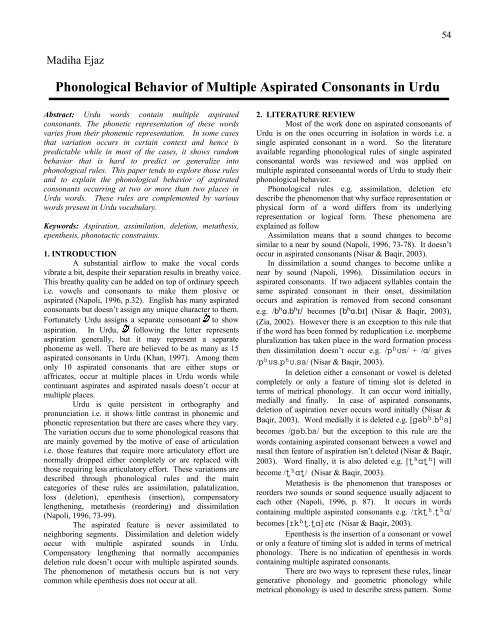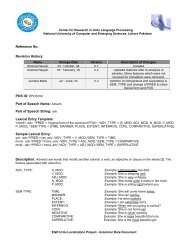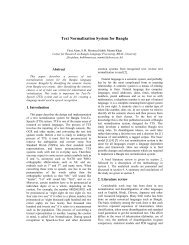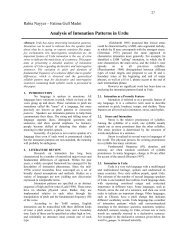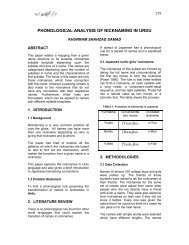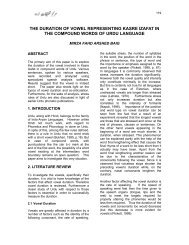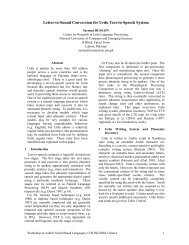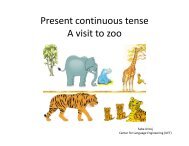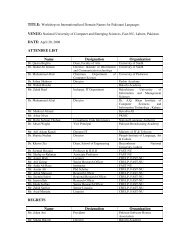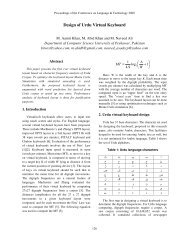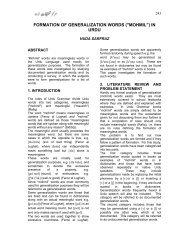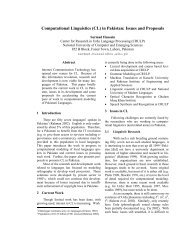Phonological Behavior of Multiple Aspirated Consonants in Urdu
Phonological Behavior of Multiple Aspirated Consonants in Urdu
Phonological Behavior of Multiple Aspirated Consonants in Urdu
You also want an ePaper? Increase the reach of your titles
YUMPU automatically turns print PDFs into web optimized ePapers that Google loves.
54Madiha Ejaz<strong>Phonological</strong> <strong>Behavior</strong> <strong>of</strong> <strong>Multiple</strong> <strong>Aspirated</strong> <strong>Consonants</strong> <strong>in</strong> <strong>Urdu</strong>Abstract: <strong>Urdu</strong> words conta<strong>in</strong> multiple aspiratedconsonants. The phonetic representation <strong>of</strong> these wordsvaries from their phonemic representation. In some casesthat variation occurs <strong>in</strong> certa<strong>in</strong> context and hence ispredictable while <strong>in</strong> most <strong>of</strong> the cases, it shows randombehavior that is hard to predict or generalize <strong>in</strong>tophonological rules. This paper tends to explore those rulesand to expla<strong>in</strong> the phonological behavior <strong>of</strong> aspiratedconsonants occurr<strong>in</strong>g at two or more than two places <strong>in</strong><strong>Urdu</strong> words. These rules are complemented by variouswords present <strong>in</strong> <strong>Urdu</strong> vocabulary.Keywords: Aspiration, assimilation, deletion, metathesis,epenthesis, phonotactic constra<strong>in</strong>ts.1. INTRODUCTIONA substantial airflow to make the vocal cordsvibrate a bit, despite their separation results <strong>in</strong> breathy voice.This breathy quality can be added on top <strong>of</strong> ord<strong>in</strong>ary speechi.e. vowels and consonants to make them plosive oraspirated (Napoli, 1996, p.32). English has many aspiratedconsonants but doesn’t assign any unique character to them.Fortunately <strong>Urdu</strong> assigns a separate consonant to showaspiration. In <strong>Urdu</strong>, follow<strong>in</strong>g the letter representsaspiration generally, but it may represent a separatephoneme as well. There are believed to be as many as 15aspirated consonants <strong>in</strong> <strong>Urdu</strong> (Khan, 1997). Among themonly 10 aspirated consonants that are either stops oraffricates, occur at multiple places <strong>in</strong> <strong>Urdu</strong> words whilecont<strong>in</strong>uant aspirates and aspirated nasals doesn’t occur atmultiple places.<strong>Urdu</strong> is quite persistent <strong>in</strong> orthography andpronunciation i.e. it shows little contrast <strong>in</strong> phonemic andphonetic representation but there are cases where they vary.The variation occurs due to some phonological reasons thatare ma<strong>in</strong>ly governed by the motive <strong>of</strong> ease <strong>of</strong> articulationi.e. those features that require more articulatory effort arenormally dropped either completely or are replaced withthose requir<strong>in</strong>g less articulatory effort. These variations aredescribed through phonological rules and the ma<strong>in</strong>categories <strong>of</strong> these rules are assimilation, palatalization,loss (deletion), epenthesis (<strong>in</strong>sertion), compensatorylengthen<strong>in</strong>g, metathesis (reorder<strong>in</strong>g) and dissimilation(Napoli, 1996, 73-99).The aspirated feature is never assimilated toneighbor<strong>in</strong>g segments. Dissimilation and deletion widelyoccur with multiple aspirated sounds <strong>in</strong> <strong>Urdu</strong>.Compensatory lengthen<strong>in</strong>g that normally accompaniesdeletion rule doesn’t occur with multiple aspirated sounds.The phenomenon <strong>of</strong> metathesis occurs but is not verycommon while epenthesis does not occur at all.2. LITERATURE REVIEWMost <strong>of</strong> the work done on aspirated consonants <strong>of</strong><strong>Urdu</strong> is on the ones occurr<strong>in</strong>g <strong>in</strong> isolation <strong>in</strong> words i.e. as<strong>in</strong>gle aspirated consonant <strong>in</strong> a word. So the literatureavailable regard<strong>in</strong>g phonological rules <strong>of</strong> s<strong>in</strong>gle aspiratedconsonantal words was reviewed and was applied onmultiple aspirated consonantal words <strong>of</strong> <strong>Urdu</strong> to study theirphonological behavior.<strong>Phonological</strong> rules e.g. assimilation, deletion etcdescribe the phenomenon that why surface representation orphysical form <strong>of</strong> a word differs from its underly<strong>in</strong>grepresentation or logical form. These phenomena areexpla<strong>in</strong>ed as followAssimilation means that a sound changes to becomesimilar to a near by sound (Napoli, 1996, 73-78). It doesn’toccur <strong>in</strong> aspirated consonants (Nisar & Baqir, 2003).In dissimilation a sound changes to become unlike anear by sound (Napoli, 1996). Dissimilation occurs <strong>in</strong>aspirated consonants. If two adjacent syllables conta<strong>in</strong> thesame aspirated consonant <strong>in</strong> their onset, dissimilationoccurs and aspiration is removed from second consonante.g. /b.b/ becomes [b.b] (Nisar & Baqir, 2003),(Zia, 2002). However there is an exception to this rule thatif the word has been formed by reduplication i.e. morphemepluralization has taken place <strong>in</strong> the word formation processthen dissimilation doesn’t occur e.g. /ps/ + // gives/ps.p.sa/ (Nisar & Baqir, 2003).In deletion either a consonant or vowel is deletedcompletely or only a feature <strong>of</strong> tim<strong>in</strong>g slot is deleted <strong>in</strong>terms <strong>of</strong> metrical phonology. It can occur word <strong>in</strong>itially,medially and f<strong>in</strong>ally. In case <strong>of</strong> aspirated consonants,deletion <strong>of</strong> aspiration never occurs word <strong>in</strong>itially (Nisar &Baqir, 2003). Word medially it is deleted e.g. [b.ba]becomes /b.ba/ but the exception to this rule are thewords conta<strong>in</strong><strong>in</strong>g aspirated consonant between a vowel andnasal then feature <strong>of</strong> aspiration isn’t deleted (Nisar & Baqir,2003). Word f<strong>in</strong>ally, it is also deleted e.g. [] willbecome // (Nisar & Baqir, 2003).Metathesis is the phenomenon that transposes orreorders two sounds or sound sequence usually adjacent toeach other (Napoli, 1996, p. 87). It occurs <strong>in</strong> wordsconta<strong>in</strong><strong>in</strong>g multiple aspirated consonants e.g. /k./becomes [k.] etc (Nisar & Baqir, 2003).Epenthesis is the <strong>in</strong>sertion <strong>of</strong> a consonant or vowelor only a feature <strong>of</strong> tim<strong>in</strong>g slot is added <strong>in</strong> terms <strong>of</strong> metricalphonology. There is no <strong>in</strong>dication <strong>of</strong> epenthesis <strong>in</strong> wordsconta<strong>in</strong><strong>in</strong>g multiple aspirated consonants.There are two ways to represent these rules, l<strong>in</strong>eargenerative phonology and geometric phonology whilemetrical phonology is used to describe stress pattern. Some
ules are better expla<strong>in</strong>ed <strong>in</strong> other than one e.g. assimilationis better described <strong>in</strong> l<strong>in</strong>ear phonology while dissimilation<strong>in</strong> geometric phonology (Napoli, 1996, p.99).Apart from phonological rules, some otherdescriptions <strong>in</strong>clude there is a period <strong>of</strong> voicelessness afterthe articulation <strong>of</strong> stop, dur<strong>in</strong>g this period a burst <strong>of</strong> aircomes out <strong>in</strong> aspirated stops (Hussa<strong>in</strong> & Nair, 1995).One <strong>of</strong> the theories regard<strong>in</strong>g the aspiratedcont<strong>in</strong>uants <strong>of</strong> <strong>Urdu</strong> is that they require more articulatoryeffort and hence they are replaced by the cont<strong>in</strong>uantfollowed by /h/ e.g. /d.la/ becomes [dl.ha], <strong>in</strong> thiscase feature <strong>of</strong> aspiration is lost and is promoted to /h/consonant and the word is re-syllabified. (Nisar & Baqir,2003). Aga<strong>in</strong> there is no <strong>in</strong>dication <strong>of</strong> multiple aspiratedsonorant consonants.3. PROBLEM STATEMENT<strong>Multiple</strong> aspirated consonants occur <strong>in</strong> a s<strong>in</strong>gle<strong>Urdu</strong> word. What phonological rules are followed byaspirated consonants occurr<strong>in</strong>g <strong>in</strong> either adjacent syllablesor different syllables <strong>of</strong> an <strong>Urdu</strong> word?4. METHODOLOGYOver 255 words conta<strong>in</strong><strong>in</strong>g multiple aspiratedconsonants were collected from the <strong>Urdu</strong> dictionary “Ferozul-loghat<strong>Urdu</strong> Jadeed New Edition”. They weretranscribed both phonemically and phonetically. In order toremove ambiguities, these words were searched <strong>in</strong> otherdictionaries like “Farhang-i-Asafiyyah” and “Nur-ul-Lughat”, f<strong>in</strong>al analysis was done on words found <strong>in</strong> at leasttwo <strong>of</strong> these dictionaries. So after remov<strong>in</strong>g ambiguities,over 80 words conta<strong>in</strong><strong>in</strong>g multiple aspirated consonantsseparated by vowel or other consonants were analyzed e.g./p.pudi/ while over 70 words conta<strong>in</strong><strong>in</strong>g aspiratedconsonants adjacent to each other were analyzed e.g./pt.tr/ etc. The English translation <strong>of</strong> these wordswas adopted from “Kitabistan’s Twentieth-CenturyStandard Dictionary”.Apart from words conta<strong>in</strong><strong>in</strong>g multiple aspiratedconsonants, some words conta<strong>in</strong><strong>in</strong>g an aspirated consonantalong with its un-aspirated counterpart were collected <strong>in</strong>order to have better understand<strong>in</strong>g e.g. /b.bk/ etc.When the data had been gathered, it was used <strong>in</strong>sentences <strong>in</strong> such a way that it always came <strong>in</strong> the middle <strong>of</strong>sentences, attempt<strong>in</strong>g to hide the actual problem. Nativespeakers were <strong>in</strong>terviewed regard<strong>in</strong>g the phoneticrepresentation <strong>of</strong> these sentences i.e. word and its carrierphrase but it was observed that if speakers were provideddata <strong>in</strong> written form and then asked to pronounce it, theypaid attention to its written form and tried to utter as muchas possible accord<strong>in</strong>g to orthography, especially <strong>in</strong> case <strong>of</strong>those words that are not commonly used, hence it wasn’ttotally reliable. Along with this it was also judged bylisten<strong>in</strong>g to native speakers day-to-day normal conversationthat is unconscious and hence more reliable.555. RESULTSThe analysis <strong>of</strong> the data showed that <strong>Urdu</strong> wordsdon’t conta<strong>in</strong> multiple cont<strong>in</strong>uant aspirates. Only twowords were found that conta<strong>in</strong>ed cont<strong>in</strong>uant aspirate /l/multiple times <strong>in</strong> their phonemic representation which are/l.l/ and /kl.l/ and they become [ l.l] and[ kl.l] respectively. <strong>Urdu</strong> words have only aspiratedstops and affricates (Appendix A). Most <strong>of</strong> the words havesimilar aspirated consonant rarely dissimilar.Regard<strong>in</strong>g, phonological rules, deletion anddissimilation are very common. Metathesis is quite rarewhile assimilation; epenthesis and compensatorylengthen<strong>in</strong>g are absent.5.1 DeletionAnalysis <strong>of</strong> data showed that aspiration is deletedfrom aspirated consonant, word medially and word f<strong>in</strong>ally.Aspiration is never deleted at beg<strong>in</strong>n<strong>in</strong>g <strong>of</strong> word.At word f<strong>in</strong>al position it is always deleted i.e. atcoda position <strong>of</strong> last syllable e.g. / tja.s/ becomes[tja.s]. [+aspirated]Rule 1. Deletion <strong>of</strong> aspiration from aspirated consonant atword boundary <strong>in</strong> words. “#” represents word boundary.The data that verifies the correctness <strong>of</strong> Rule 1 is given <strong>in</strong>Table B1 (Appendix B).Word medially, aspiration is deleted either syllable<strong>in</strong>itially or syllable f<strong>in</strong>ally or whole segment is deleteddepend<strong>in</strong>g on the context.The word that beg<strong>in</strong> with a vowel and that vowelprecedes aspirated consonant <strong>in</strong> the first syllable, entiresegment is deleted e.g. /d.dm/ becomes [.dm].[-tense]X[+syllabic]X #[-nasal][-cont<strong>in</strong>uant][+aspirated]X[-nasal][-cont<strong>in</strong>uant][+aspirated]. X[-nasal][-cont<strong>in</strong>uant]Rule 2. Deletion <strong>of</strong> entire segment word medially. “.”represents syllable boundary. The data that verifies thecorrectness <strong>of</strong> Rule 2 is given <strong>in</strong> Table B2 (Appendix B).The words that beg<strong>in</strong> with a consonant and theaspirated consonant at coda <strong>of</strong> first syllable is voiced whilethe other aspirated consonant at the onset <strong>of</strong> second syllable
is also voiced, then aspiration gets deleted from bothconsonants e.g. /b.i/ becomes [b.i].[+aspirated]X[+aspirated]. X565.2 DissimilationDissimilation occurs <strong>in</strong> those words where bothaspirated consonants are similar and they occur at onsetposition <strong>of</strong> adjacent syllables.If the aspirated consonants are voiced thenaspiration dissimilates e.g. /br.b.r/ becomes[br.b.r].[+aspirated][+aspirated][-nasal][-cont<strong>in</strong>uant][+voiced][-nasal][-cont<strong>in</strong>uant][+voiced]X V (V) (C) . XRule 3. Deletion <strong>of</strong> aspiration both syllable f<strong>in</strong>ally and<strong>in</strong>itially <strong>in</strong> case <strong>of</strong> voiced aspirated consonants. The datathat verifies the correctness <strong>of</strong> Rule 3 is given <strong>in</strong> Table B3(Appendix B).The words that beg<strong>in</strong> with a consonant and both <strong>of</strong>the aspirated consonants, one at coda <strong>of</strong> first syllable andother at onset <strong>of</strong> second syllable, are unvoiced, thenaspiration gets deleted from consonant at coda <strong>of</strong> firstsyllable e.g. /t.i/ becomes [t.i].[+aspirated]X[-nasal][-cont<strong>in</strong>uant][-voiced]Rule 4. Deletion <strong>of</strong> aspiration syllable f<strong>in</strong>ally <strong>in</strong> case <strong>of</strong>unvoiced aspirated consonants. The data that verifies thecorrectness <strong>of</strong> Rule 4 is given <strong>in</strong> Table B4 (Appendix B).Aspiration gets deleted syllable f<strong>in</strong>ally <strong>in</strong> any otherscenario e.g. /a.ra/ becomes [a.ra] etc but there are afew exception to this rule e.g. /tot.ni/ rema<strong>in</strong>s same. Herethe rule is that if aspirated consonant is preceded by avowel and is followed by a coronal nasal then aspirationisn’t deleted.[+aspirated]X .[-nasal][-cont<strong>in</strong>uant][+aspirated]. X[-nasal][-cont<strong>in</strong>uant][-voiced]Rule 5. Deletion <strong>of</strong> aspiration syllable f<strong>in</strong>ally. The data thatverifies the correctness <strong>of</strong> Rule 5 is given <strong>in</strong> Table B4(Appendix B).[-nasal][-cont<strong>in</strong>uant][+voiced][-nasal][-cont<strong>in</strong>uant][+voiced]Rule 6. Dissimilation <strong>of</strong> aspiration syllable <strong>in</strong>itially <strong>in</strong> case<strong>of</strong> voiced aspirated consonants. V represents s<strong>in</strong>gle tim<strong>in</strong>gslot. The data that verifies the correctness <strong>of</strong> Rule 5 isgiven <strong>in</strong> Table C1 (Appendix C).If aspirated consonant are unvoiced then aspirationdoesn’t dissimilate, provided that nucleus <strong>of</strong> both thesyllables <strong>in</strong> which they occur, are identical e.g./kl.k.la.na/ rema<strong>in</strong>s same. The data that verifies it isprovided <strong>in</strong> Table C2 (Appendix C).However there are a few exceptions to this rulewhere aspiration is deleted e.g. /k.k.a.na/ becomes[k.k.a.na] and it follows the rule that if the coda <strong>of</strong>the first syllable has an obstruent consonant then aspirationis deleted from follow<strong>in</strong>g consonant.[-voiced][+aspirated]X V (V) C . X V (V)[-nasal][-cont<strong>in</strong>uant][-aspirated][-voiced][+aspirated][-sonorant] [-nasal][-cont<strong>in</strong>uant]Rule 7. Dissimilation <strong>of</strong> aspiration syllable <strong>in</strong>itially <strong>in</strong> case<strong>of</strong> unvoiced aspirated consonants. V represents vowel andthey are same <strong>in</strong> both syllables. It could be short or long.The data that verifies the correctness <strong>of</strong> Rule 6 is given <strong>in</strong>Table C3 (Appendix C).In rest <strong>of</strong> the cases, aspiration dissimilates. The data thatverifies it is given <strong>in</strong> Table C4 (Appendix C).All rules that have been discussed so far are thosefor the similar aspirated consonants, <strong>in</strong> case <strong>of</strong> dissimilaraspirated consonants, aspiration is always deleted wordmedially. The data that verifies it is provided <strong>in</strong> Table C4(Appendix C).
5.3 MetathesisThere is only one examples that shows metathesisi.e. /k./ becomes [k.] and it is <strong>of</strong> course<strong>in</strong>sufficient to generalize it <strong>in</strong>to a rule.6. DISCUSSIONRegard<strong>in</strong>g phonological rules; voic<strong>in</strong>g and syllablestructure play a very important rule. Aspiration is alwaysdeleted word f<strong>in</strong>ally and never deleted word <strong>in</strong>itially.Word medially, it is deleted either syllable <strong>in</strong>itially orf<strong>in</strong>ally depend<strong>in</strong>g on the follow<strong>in</strong>g contexts.‣ If the word beg<strong>in</strong>s with a vowel and has agem<strong>in</strong>ate aspirated stop then the whole segmentis deleted e.g. /.a.vn/ becomes[.a.vn].‣ If the word beg<strong>in</strong>s with a consonant and has agem<strong>in</strong>ate voiced aspirated stop then aspirationgets deleted from both <strong>of</strong> the consonants e.g./b.a/ becomes [b.a].‣ If the word beg<strong>in</strong>s with a consonant and has agem<strong>in</strong>ate un-voiced aspirated stop thenaspiration gets deleted from first consonant i.e.end <strong>of</strong> first syllable e.g. /lt.tn/ becomes[lt.tn] but there are a few exception tothis rule. L<strong>in</strong>e 12 and 24 <strong>of</strong> Table B4(Appendix B), /dk.ki / becomes [d.ki] and[m.a] becomes / ma.a /. In secondcase compensatory lengthen<strong>in</strong>g <strong>of</strong> the vowel //takes place after the deletion <strong>of</strong> the wholesegment //.Dissimilation occurs <strong>in</strong> follow<strong>in</strong>g context‣ If the word has same aspirated consonant atonset and coda <strong>of</strong> first syllable then theaspiration gets deleted at coda e.g. /dd.ri/becomes [dd.ri]. There is an exception tothis rule. L<strong>in</strong>e 8 <strong>of</strong> Table B5 (Appendix B),/kok.la/ becomes [ko.kla] by resyllabification.‣ If both aspirated consonant are voiced and theylie syllable <strong>in</strong>itially <strong>in</strong> adjacent syllable thenaspiration gets deleted from consonant <strong>in</strong>second syllable even if reduplication is there e.g./dn.d/ becomes [dn.d]. Itcontradicts early work, <strong>in</strong> which it was statedthat aspiration doesn’t dissimilate <strong>in</strong> case <strong>of</strong>reduplication‣ If both aspirated consonant are un-voiced andthey lie syllable <strong>in</strong>itially <strong>in</strong> adjacent syllablethen aspiration does not dissimilate ifreduplication is there e.g. [p.p.a.na]rema<strong>in</strong>s same but if the consonant at codaposition <strong>of</strong> first syllable is not sonorant thenaspiration dissimilates.‣ In rest <strong>of</strong> the cases it gets deleted.57Another <strong>in</strong>terest<strong>in</strong>g observation was that when a voicedaspirated consonant occurs syllable <strong>in</strong>itially <strong>in</strong> the firstsyllable and the same voiced un-aspirated consonant occurssyllable <strong>in</strong>itially <strong>in</strong> adjacent syllable, the feature <strong>of</strong> voic<strong>in</strong>gdisappears from the un-aspirated consonant. Its possibleexplanation is the fact that there is a period <strong>of</strong> voicelessnessafter the articulation <strong>of</strong> stop, dur<strong>in</strong>g this period a burst <strong>of</strong> aircomes out <strong>in</strong> aspirated stops and this voicelessnessassimilates to the next segment e.g. /b.bk/ becomes[b.pk], /d.dk/ becomes /d.tk/ etc. It is openfor further experimentation.REFERENCES- Ahmed, M.S. Farhenge-e-Asfiah. Sang-e-meelPublishers.2002.- Haqqi, Shan-ul-haq. Farhang-e-Talffuz. Muqtadra QaumiZubaan, Islamabad. 1995.- Feroz-ud-D, M. Feroz-ul-Lughat <strong>Urdu</strong> Jammi.Ferozsons, Lahore.- Pr<strong>of</strong>. Quraeshi, Bashir Ahmad. Standard TwentiethCentury Dictionary (<strong>Urdu</strong> <strong>in</strong>to English). KitabistanPublish<strong>in</strong>g, Lahore. 1992.- Napoli, Donna Jo. L<strong>in</strong>guistics An IntroductionOxfordUniversity Press, USA. 1996.- Khan, M. <strong>Urdu</strong> Ka Sauti Nizam. Muqtadara QaumiZaban, Islamabad. 1997.- Hussa<strong>in</strong> and Nair. Phonetic Correlates <strong>of</strong> Lexical Stress<strong>in</strong> <strong>Urdu</strong>. Unpublished Ph.D. dissertation,Northwestern University, IL, USA, 1995.- Sadaf Nawaz. Deletion rules <strong>in</strong> <strong>Urdu</strong> language.Akhbar-e-<strong>Urdu</strong>, 2002.- Ayesha Zia. Assimilation and dissimilation rules <strong>in</strong><strong>Urdu</strong>. Akhbar-e-<strong>Urdu</strong>, 2002.- Adnan Nisar and Zeeshan Baqir. <strong>Phonological</strong>behavior <strong>of</strong> aspirated consonants <strong>in</strong> <strong>Urdu</strong>. Akhbar-e-<strong>Urdu</strong>, 2003.- www.geocities.com/sikmirza/arabic/urdu_alph.html.
APPENDIX A58IPA Letter IPA Letterp.. ..bkAPPENDIX BtdtdTable B1: Data po<strong>in</strong>t to verify correctness <strong>of</strong> Rule 1.No PhonemicPhoneticMean<strong>in</strong>g <strong>in</strong> EnglishTranscription Transcription1 Crowd2 a a Splendor3 Pure4 n n Leafless branch5 dad dad Heat6 tat tat Dilute curd7 tja.s tja.s Sixty sixTable B2: Data po<strong>in</strong>t to verify correctness <strong>of</strong> Rule 2.No PhonemicPhoneticMean<strong>in</strong>g <strong>in</strong> EnglishTranscription Transcription1 t.tl .tl Shallow2 .a .a Eight (at cards)3 .a.ra .a.ra Eighteen4 .a.vn .a.vn Fifty eight5 t.ta .ta Good, sound, pleas<strong>in</strong>g6 t.tu .tu Suffocation7 d. da . da Half a bottle8 d.dm .dm Noise, turmoil, disturbance9 d.di .di Old co<strong>in</strong> equivalent to half“damri”Table B3: Data po<strong>in</strong>t to verify correctness <strong>of</strong> Rule 3.No PhonemicPhoneticMean<strong>in</strong>g <strong>in</strong> EnglishTranscription Transcription1 bd.du bd.du Simpleton, fool2 b.a b.a Old man3 b.i b.i Carriage4 b.ba b.ba Carpet with patched pattern
59Table B4: Data po<strong>in</strong>t to verify correctness <strong>of</strong> Rule 4.No PhonemicPhoneticMean<strong>in</strong>g <strong>in</strong> EnglishTranscription Transcription1 bt.tu bt.tu Scorpion2 pt.tr pt.tr Stone3 p.a p.a Young person4 p.a p.a Buttock5 p.u p.u Stooge6 p.e p.e Muscles7 pt.tm pt.tm Western8 t.a t.a Sk<strong>in</strong> spot9 t.a t.a Pay roll10 t.i t.i Letter11 dk.kn dk.kn South12 dk.ki d.ki Sad13 kt.ta kt.ta Catechu14 p.pa up.pa Bunch15 t.ti t.ti Complication16 .a .a Bundle17 lt.ta lt.ta Ske<strong>in</strong>18 lt.tn lt.tn Signs19 m.u m.u Talkative child20 mt.tr mt.tr Mosquito21 mk.kn mk.kn Butter22 m.l.i m.l.i Liquorices23 m.a ma.a Slow24 ht.ti ht.ti HandleTable B5: Data po<strong>in</strong>t to verify correctness <strong>of</strong> Rule 5.No PhonemicPhoneticMean<strong>in</strong>g <strong>in</strong> EnglishTranscription Transcription1 pp.a pp.a Lungs2 tot.ni Rema<strong>in</strong>s same Animals po<strong>in</strong>ted mouth3 .a .a Laughter4 dnd.la.na dnd.la.na Irritated5 dd.ri dd.ri Small earthen flask6 tt.la tt.la Shallow7 tit.a ti.t.a Sk<strong>in</strong>ny part <strong>of</strong> flesh8 kok.la ko.kla Hollow9 a.ra a.ra Long skirt
APPENDIX CTable C1: Data po<strong>in</strong>t to verify correctness <strong>of</strong> Rule 6.60No PhonemicPhoneticMean<strong>in</strong>g <strong>in</strong> EnglishTranscription Transcription1 ba.br ba.br A k<strong>in</strong>d <strong>of</strong> plant yield<strong>in</strong>g fiber forbed str<strong>in</strong>gs.2 b.bi b.bi Sister <strong>in</strong> law3 b.but b.but Ashes4 br.b.r br.b.r Crisp5 b.b.ra.na b.b.ra.na Spr<strong>in</strong>kle6 br.bn br.bn Upset7 b.b.a.na b.b.a.na Play or beat tabla8 b.bu.da b.bu.da One whose trade is parch gra<strong>in</strong>9 bn.bo.na bn.bo.na Gnaw10 bn.b.na.na bn.b.na.na Buzz11 da.dn da.dn Anklet with small bells12 dr.d.ra dr.d.ra Flimsy13 dr.d.ra dr.d.ra Shiver<strong>in</strong>g fit14 d.d.ra.na d.d.ra.na Shake suddenly15 dl.d.la.na dl.d.la.na Glisten16 dm.d.ma.na dm.d.ma.na Glitter17 dn.d dn.d Trouble18 dn.do.na dn.do.na Shake to rouse19 dn.dna dn.dna Rattle20 dn.dn.ja dn.dn.ja Fetters21 dn.di dn.di Broken at top22 d.d.i d.d.i Anxiety23 n.or .or Dark cloud24 .t u.t Veil25 o.a o.a Couch shellTable C2:No PhonemicPhoneticMean<strong>in</strong>g <strong>in</strong> EnglishTranscription Transcription1 pr.pn.di Rema<strong>in</strong>s same Tricky2 p.p.a.na Rema<strong>in</strong>s same Flutter3 ps.p.sa Rema<strong>in</strong>s same Spongy4 pn.p.na.na Rema<strong>in</strong>s same Spread the hood and hiss5 tr.t.ra.na Rema<strong>in</strong>s same Shake6 tr.t.ri Rema<strong>in</strong>s same Vibration7 n.t.na.h Rema<strong>in</strong>s same T<strong>in</strong>kle <strong>of</strong> small bells8 kl.k.la.na Rema<strong>in</strong>s same Giggle9 kn.k.na Rema<strong>in</strong>s same Cracked10 kn.k.na.na Rema<strong>in</strong>s same Wail with a nasal sound
61Table C3: Data po<strong>in</strong>t to verify correctness <strong>of</strong> Rule 7.No PhonemicPhoneticMean<strong>in</strong>g <strong>in</strong> EnglishTranscription Transcription1 pt.p.a.na pt.p.a.na Move w<strong>in</strong>gs rapidly2 tk.t.ka.na tk.t.ka.na Hate3 k.k.a.na k.k.a.na KnockTable C4:Table C5:No PhonemicPhoneticMean<strong>in</strong>g <strong>in</strong> EnglishTranscription Transcription1 p.po.la p.po.la Blister2 p.po.di p.po.di Mould3 pp.pi pp.pi Aunt4 t.ta.na t.ta.na Pout5 .r.na .r.na Shiver6 .k.na .k.na Come to sudden stop7 .ol .ol Ridicule8 ..ra ..ra Seller <strong>of</strong> vessels9 t.tl.na t.tl.na Fly past with just a touch10 t.tu.dr t.tu.dr Mole12 t.to.ra t.to.ra Childish13 tu.tk tu.tk A ceremony14 k.ke k.ke Va<strong>in</strong>15 kn.kar.na kn.kar.na Clear the throat16 ko.ka Rema<strong>in</strong>s same StallNo PhonemicPhoneticMean<strong>in</strong>g <strong>in</strong> EnglishTranscription Transcription1 b.k b.k Dialect2 pl.d.i pl.d.i Small founta<strong>in</strong> like fire work3 d.ro.ka d.ro.ka W<strong>in</strong>dow


